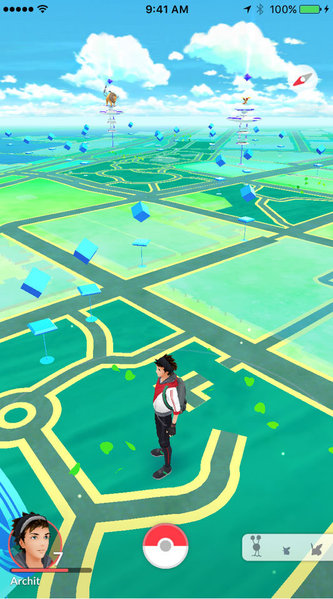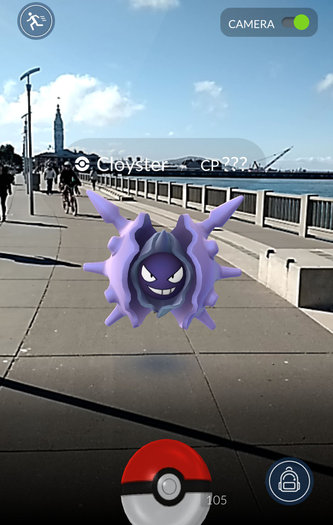In the brief week or so since it released, Pokemon GO has been taking the world by storm, and has become nothing short of a phenomenon. Released the world over for both iPhones and Android devices, Pokemon GO is a game that brings Nintendo's famous Pokemon out of your handheld, and into the real world. While previous Pokemon games have been about exploring a virtual world and catching, training and raising the various wild animals you find lurking in the (in-game) long grass, Pokemon GO instead turns the world around you into one big scavenger hunt, as you set out to collect the creatures in the real world.
With every man and their dog/Arcanine now playing, the chances are at least someone in your family has downloaded the app. But with media reports of accidents, disturbing discoveries, and even muggings rapidly popping up as people follow Pokemon GO around, many parents have just one question - just how safe is Pokemon GO? To answer that question, we should probably explain a little more about how the game works.
The Basics
Encouraging you to go outside and explore, Pokemon GO makes use of your phone's GPS and internet/mobile data (you'll need to use mobile data when out and about for this to work properly - and it eats data like no-one's business) to present you with a map of your local area. Somewhere around you, there will be Pokemon hiding - and they'll only pop up on the map when you're within a certain radius of them. In the bottom right, there's a menu that will give you an idea of which Pokemon are at least vaguely nearby - and its up to you to wander the streets in search of the elusive critters.

The blue squares are Pokestops, where you can pick up supplies - and the big towers in the distance are Pokemon gyms
Contrary to what some reports suggest, should you encounter a Pokemon, you don't actually need to get all that close to it to catch it - while memes and parts of the internet have filled up with reports of people "having" to enter people's back gardens and check under rocks, once a Pokemon's popped up on the map, all you need to do is tap it to enter into a "battle". Unusually, this "battle" doesn't actually involve any battling at all, as you simply lob a few Pokeballs at it to capture it, and add it to your collection.
Once you have a few Pokemon under your belt, you can start challenging Pokemon 'gyms' - strongholds where other players have placed their strongest critters, and left them to battle, with real-life landmarks such as pubs, stations and parks becoming Pokemon gyms in the game.
The other major local landmark you'll find yourself visiting are Pokestops. Shown as blue cubes on your map, these represent points around your local area where you can nab a few extra pokeballs - and, if you're really lucky, maybe some incense, a pokemon egg, or a potion. If you want to keep catching Pokemon, you'll need to keep visiting these to keep your supply of pokeballs topped up.
Like most mobile phone games, Pokemon GO also lets you buy extra items through "in app purchases", or micro-transactions - while the game itself costs nothing to play, and you can progress fairly easily without spending a penny, you do have the option to pay for a few extras. Pokecoins - gold coins emblazoned with a picture of Pikachu - are the game's virtual currency and can be used to buy everything, from the game's creature capturing Pokeballs, to rare Pokemon attracting Lures and Incense, or health restoring potions. Almost all items can be acquired in-game in relatively limited quantities from Pokestops, or when your character levels up, but for a bit of cash you can get more - 79p will net you 100 Pokecoins, which is enough for 20 extra Pokeballs or a single use lure. Prices escalate from there, to a seriously crazy bundle of 14,500 Pokecoins for an eye-watering £79.99 - although on the plus side you'd probably never run out of Pokeballs again. Unless you're a really crap shot.
The risks
While Nintendo and developers Niantic may intend Pokemon GO to be light-hearted fun - and for the vast majority of users, it will be - there is undoubtedly going to be potential for a game like this to go wrong. Any game that involves asking users to follow their mobile phone and play a game while out and about has the potential to lead to meetings with the wrong kinds of people, as while a gym, or pokestop may be just around the corner, it may also be in a rough area - the kind of area you don't really want to walk into brandishing a shiny new mobile phone.
The item that's proving the riskiest so far is the aforementioned lure - and in fact, it's these that were exploited in the US. Lures can be dropped at Pokestops, and can be seen on any nearby players' phones as a swirl of pink petals around that point. Lures are intended to be a kind of social buff, and by dropping a lure at a Pokestop, you'll attract Pokemon to that area - Pokemon that you, your friends, and any other players in the area can catch. As you'd likely imagine, then, when a lure has been dropped, a steady stream of people will soon appear, looking to catch any Pokemon that might appear (and as each Pokemon can be caught more than once, whoever drops the lure doesn't have to worry about people nabbing their catch, either).
The problem is, this obviously brings with it a few very obvious problems. If you live in a more remote area - or if you go out playing Pokemon GO late at night - rapists, paedophiles and muggers could - and at least in the case of muggers, have been - taking advantage of this. All they need do is drop a lure, and unsuspecting players will see the telltale petals, before heading off to check it out - presumably expecting to just meet another fellow player on Pokemon GO, rather than a mugger who'll hold them up at gunpoint.
While most of the 'Pokestop' landmark locations are in town centres and other public places, some may be in some less salubrious areas, and an unsuspecting child may find themselves wandering through the "wrong part of town" on the search for an elusive Pikachu. In our home town of Stourbridge, one such Pokestop is located at what is affectionately known as the 'Murder Bridge' - a now-demolished railway bridge that was supposedly the site of a number of murders and a train crash over the years. Sounds like the perfect place for a family outing, right?

Pokestops encourage you to visit various landmarks by rewarding you with items.
Likewise there's also a danger of children straying too far, because it's always 'just a little further' to the next Jigglypuff or whatever - and once they're lost, away from familiar locations, they may not be able to find their way back. It also makes them easy pickings for the aforementioned criminals too. About the only saving grace is that, with Pokemon GO being a phone game, they should at least be able to phone someone up should they get in trouble during their Pokemon catching quest - although with that being said, the game is also an incredible battery drain.
How to stay safe
So, those are the risks - but how do you go about staying safe? It goes without saying that everything in life involves risks, but there are ways you can keep Pokemon GO a safe and friendly game, rather than an expensive trip out.
It's probably worth impressing on your little Pokemon trainers that, should they find themselves lost, they should ring you and wait where they are, being careful of strangers until you get there - and make sure they always have some credit left, just in case.
If they do go out hunting Pokemon, it's also best to make sure they go together with a friend - or preferably, in a larger group - as there's safety in numbers, and a social game like this is more fun like that too.
If you can, it's probably best to make sure that your children aren't using a mega fancy expensive smartphone for their adventures, either, and are instead playing on a more basic device that has less appeal to thieves. Either that, or they should try and keep their phone in a pocket, or otherwise out of sight as much as they can - you can actually manage this by keeping your phone in your pocket, and tapping the screen (or a non-important button) periodically to stop it going to sleep. As the game will vibrate when a Pokemon shows up, your child then only has to have their phone out and visible for the minimal amount of time.
And, finally, it's also important to make sure that your little ones always stay fully aware of their surroundings. As much of the action in Pokemon GO happens on the phone screen, children in particular could find themselves so absorbed in what's going on in the game that they stop paying attention to their surroundings. News reports from the good old United States of Accidents have already had adults walking off cliffs, causing car crashes after jaywalking because they're so focussed on their mobiles, and a young girl actually being hit by a car, breaking her collarbone having walked out onto a busy intersection without looking - and that's just naming a few. Lamposts, billboards and bollards are much more benign threats, although folks in the Midlands should watch out for sudden canals creeping up on you and throwing you off your Geodude-catching groove. Either way, while most children are arguably going to be more sensible than the roster of berks above, it's well worth having a chat with your little Pokemon GO-ers and impressing the importance of paying attention while playing, just in case.

We wonder if this Pokemon GO user is aware of the cyclist heading straight for them...
While we remain a little sceptical about Pokemon GO's lasting appeal, there's no doubt about it's popularity at the moment - walk down the street, and you'll likely see every other person, young and old, tailing virtual critters. As a light-hearted game that encourages people to go out, enjoy the sunshine and get some stealthy exercise, it does a great job - but it does also open the door for all kinds of unscrupulous folks to take advantage of the hype. Just be sure to Pokemon GO with care, and you'll be fine.












